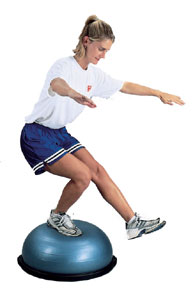If you’ve been to any gym, no doubt you’ve seen someone balancing on half of a stability ball or foam roller. You might have even asked yourself, “SELF, what is that crazy person doing – are they training for the circus?” Well, maybe you haven’t said that, but I certainly have. Unstable Surface Training (“UST” for the rest of this article) is still somehow a popular trend in exercise, and given the mountain of scientific evidence against its effectiveness, I’m not sure why.
Let’s define UST as performing any form of exercise on an unstable surface. So this could be standing on top of half a stability ball performing a squat, doing a bench press off of a stability ball, or pretty much any form of exercise that takes the body off of a stable surface, the solid ground. I want to quickly dispel some of the myths associated with UST, so you don’t make the mistake of trying it.
Myth #1:
UST Improves Balance
In fact, the truth is quite the opposite. Since our bodies already maintain balance on a stable surface our body’s mechanics, muscle activation patterns, and other feedback cues are so different on an unstable surface that UST doesn’t optimally translate to better balance on stable surfaces.
Myth #2:
UST Activates More Core Strength
Two buzz words in the same sentence (core and UST) — I almost don’t know where to begin. Once again, this is flat out wrong! Research that compares exercises (for example: a squat with a bar on your back) on unstable vs. stable surfaces show that the stable surface exercise actually activates more “core” musculature, primarily because the body doesn’t have to worry about balancing itself on an unstable surface. If you want “core” activation, you would be better off doing squats with a 15 pound bar on your back on solid ground versus squatting with no weight on an unstable surface.
Myth #3:
UST Is More Functional
This is one of my favorite ones!!! First, I’m not even really sure what this means when people say it, but a lot of people say it! If by “functional” you mean, “similar to what we do during our daily life” (which is how I would define “function”), then I don’t know how even a first grader could even think this was true. Unless you are planning on spending your day inside of a moonwalk, bouncing back and forth, I don’t know how UST is functional in the least. We walk on solid ground, not an unstable surface. If you want to maximize function, exercise on the same surface you spend your day on.
Myth #4:
UST Is Great for Sports Performance
I can probably say just refer back to myth #3 on this one, with few exceptions. Sports are played on STABLE surfaces, so not only does training on unstable surfaces not transfer in terms of performance enhancement, it can actually degrade stability and disrupt well-learned motor patterns once an athlete goes back to the stable surface.
So is UST good for anything?
Yes, but in a narrow scope. It’s good for rehab (in certain cases). It’s also good for workout variety, if you’re looking for something a little different. However, in terms of getting optimal results from your workouts, UST is a waste of time.
About the Author:
-

Michael Stack is the founder & CEO of Applied Fitness Solutions and Frontline Fitness Pros. He is a faculty lecturer for the University of Michigan’s School of Kinesiology. He is also the creator and the host of the Wellness Paradox Podcast, produced in conjunction with University of Michigan.
Michael is an exercise physiologist by training and a health entrepreneur, health educator, and fitness industry advocate by trade. He is dedicated to enhancing the standard of practice of, and advocating for, fitness and wellness professionals to ensure they become an essential constituent in the healthcare delivery system.
With a career spanning over three decades in fitness, health, and wellness Michael has a deep knowledge of exercise physiology, health/wellness coaching, lifestyle interventions to mitigate chronic disease and leadership. He is credentialed through the American College of Sports Medicine (ACSM) as an Exercise Physiologist (ACSM-EP), Exercise is Medicine practitioner (ASCM-EIM), and a Physical Activity in Public Health Specialist (ACSM-PAPHS). Michael is a National Strength & Conditioning Association (NSCA) Certified Strength & Conditioning Specialist (CSCS), and a CDC Diabetes Prevention Program (DPP) Lifestyle Coach.
Michael received his undergraduate degree from the University of Michigan’s School of Kinesiology in 2004 and is currently a Master’s of Public Health (MPH) candidate at University of Michigan, with a specific concentration in health behavior and health education.
Michael is a board of directors’ member for the Physical Activity Alliance and Michigan Fitness Clubs Association. He sits on the University of Michigan’s School of Kinesiology Alumni Board of Governors. Michael is an expert curriculum reviewer for the American College of Lifestyle Medicine. Finally, he is a member of the executive leadership team for American Heart Association’s Heart Walk.
Michael lectures nationally for several health/fitness certification and continuing educations, including; IHRSA, the Medical Fitness Association, the National Strength & Conditioning Association, and SCW Fitness.

